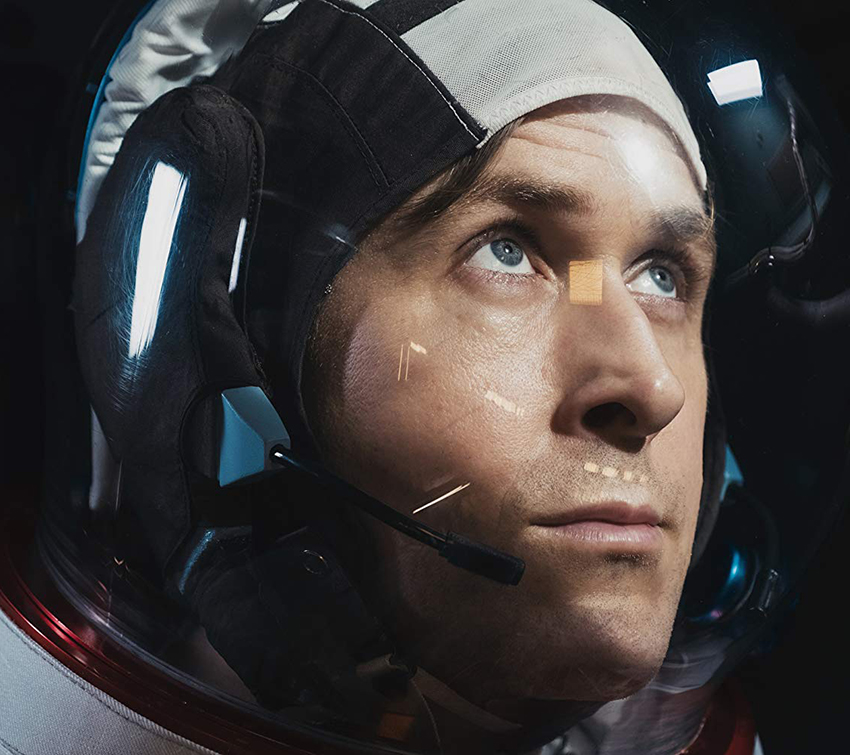 “First Man,” the new film by Damien Chazelle, begins in space. Neil Armstrong, a NASA test pilot, is flying a rocket plane on a test-run. But we before we get any context of Neil’s presence, or even what he is doing, we are keyed into the situation by sound. There’s the rickety hum of engines, and the frenetic noise of the aircraft and there is the tense, and laboured, breathing of a man. Our “First Man.” Gradually the film will begin to give us some context. We will come to realise that Neil is alone, and as his plane malfunctions, the camera’s restlessness and the cacophony of sound intensifies. “First Man” and its place in representations of space on film has been praised for its interest in representing the subjectivity of space travel – the claustrophobia, the unease, the dread, the chaos and the commitment required to survive it all. The opening establishes this well, especially that subjectivity. At just over five minutes, this is the shortest of the three trips to space that give the film its narrative structure, but is unrelentingly effective. Without ever seeing Armstrong’s face in full we get a clear glimpse into his character and his emotions in an excellent opening. But “First Man” is not just this opening. And it is not just about space.
“First Man,” the new film by Damien Chazelle, begins in space. Neil Armstrong, a NASA test pilot, is flying a rocket plane on a test-run. But we before we get any context of Neil’s presence, or even what he is doing, we are keyed into the situation by sound. There’s the rickety hum of engines, and the frenetic noise of the aircraft and there is the tense, and laboured, breathing of a man. Our “First Man.” Gradually the film will begin to give us some context. We will come to realise that Neil is alone, and as his plane malfunctions, the camera’s restlessness and the cacophony of sound intensifies. “First Man” and its place in representations of space on film has been praised for its interest in representing the subjectivity of space travel – the claustrophobia, the unease, the dread, the chaos and the commitment required to survive it all. The opening establishes this well, especially that subjectivity. At just over five minutes, this is the shortest of the three trips to space that give the film its narrative structure, but is unrelentingly effective. Without ever seeing Armstrong’s face in full we get a clear glimpse into his character and his emotions in an excellent opening. But “First Man” is not just this opening. And it is not just about space.
Chazelle’s biographical drama traces the life of Armstrong from that opening trip in 1961 up to the Apollo 11 moon landing in 1969. This description suggests much more linearity than the film provides, though. Rather than a step by step, plot-driven, build up to the moon landing, “First Man” is better surmised as a sort of restless observations of Armstrong’s life. It is a life spent a strange sort of repose but for those moments he journeys into space. Although adapted from the biography with the same title, “First Man” rejects the privileging of clarity and transparency that you would expect from a biopic. Unlike James R Hansen’s biography, Josh Singer’s script does not trace Armstrong’s life from childhood to after the mission, but instead is tightly focused on those nine years in the 1960s. The death of his daughter to cancer seems to propel to Armstrong to apply for Project Gemini as a NASA astronaut. And this decision, near the beginning of the film, is the rare moment that seeks to project any interiority onto this man. As represented in “First Man,” though, Armstrong is a man who rejects any acknowledgement of interiority.
The ice running through the veins of the very taciturn Neil Armstrong gives the film its chilly aesthetic and its chilly tone. It’s a deliberate and painstaking symbiosis between content and form that informs the film even as it complicates the long moments of the narrative that are not in space. The routine mundaneness of the space training programme makes sense when considered as a work drama, but feels less informative when rendered as a subjective view of this first man. The chaotic space trip of the opening feels masterful, and slightly incongruous with the rest of the film. The later trips to space lose some of the subjectivity of the first, most likely because he does not take them alone. But they do weaponise the subjective point of view in privileging the headspace of its astronauts. In the final trip, the use of silence to predicate the majesty in a moment towards the end is wonderful to behold. But it is the first trip that sticks in my memory. Of all the space moments, it’s the one that most readily projects Armstrong’s emotions even when we cannot see him. There is no inscrutability. Instead, the scene telegraphs his wonder, fear, and concern with aplomb. It feels faintly ironic that when his helmet comes off and we encounter him, as played by Ryan Gosling, the man becomes startlingly opaque.
It’s an opacity that persists even when Linus Sandgren’s camera is obsessed with faces at the expense of bodies with the eyes consistently staring back at us from the screen. Midway through the film, Armstrong is informed of the death of some colleagues in a work accident. The camera closes in on his face so much that his hair and forehead are momentarily obscured. It’s a consistent technique the film deploys and it reads, at first, as a move towards humanistic enquiry until we realise that Gosling as Armstrong is bullishly intent on providing little emotional cues for us and those around him. This is a man built on his stoicism.
The emotional distancing becomes part of the text in “First Man.” There’s an intriguing imperviousness to much that is represented that reminds me of Oscar Wilde’s ruminations on nature. ‘We regard Nature as the collection of phenomena external to man; people only discover in her what they bring to her.’ It’s that same invocation of naturalism that makes Chazelle’s work on “First Man” so technically complex even as it frustrates. The thematic resonance of the film (beyond the obvious: anything worth having takes time to achieve) is very much based on what the audience brings to it. But, it feels odd that we are placed outside of Armstrong’s perspective (kept at distance), rather than being (beyond that opening scene) allowed inside to understand him.
Throughout “First Man,” I kept wondering how my perspective might shift if I were American. The film is not about Americana writ large on screen, but space travel seems foreign to me in a way that seems to represent this region. Not just in the spatial sense of its dance but culturally and ethically and socially. It’s not something that defines the Guyanese experience. When Armstrong lands on the moon, his words there have reverberated through history, ‘That’s one small step for [a] man, one giant leap for mankind.’ The teasing irony of the line is made even more profound in “First Man,” which centres Armstrong’s taciturnity as key to his success, where subjectivity and not community feels like the key. I wondered, at the end, whether Chazelle really did think the moon landing signalled a giant step for mankind. And then I realised that maybe he wants me to decide on my own. I’m still not sure.
The brief moments that provide context of the world outside of NASA, an effective textual choice, presents a wealth of conflicting inferences. “I can’t pay no doctor bill, but Whitey’s on the moon,” jazz poet Gil Scott-Heron recites in a series of brief clips showing public push-back against the money spent on the project. The buoyancy of the song belies its implications of societal imbalance. Persons of colour struggle as a white man flies to the moon. Except, this scene occurs moments after a key scene depicting Armstrong’s own existential uncertainty and physical struggle in aid of this trip to the moon. The placement seems to subtly but sternly argue against the idea that space travel is some easy lark. Whitey’s on the moon but he’s not just having any fun. The more pressing question might be is it worth getting Whitey on the moon, not just for the country, but for him? But, it seems no accident that the last real world context the film provides is a speech from JFK as he talks about having the tenacity to continue in the face of roadblocks. The last frame of the film reframes this question, privileging a private moment with the Armstrong that seems to reject the public space the mission plays in history. It begins in space, but ends with its two feet firmly planted on the earth. The ending on earth feels thematically uneven, though, as a window into this “First Man,” when it’s only in the moments in space where we ever seem to understand who Neil Armstrong is.
“First Man” is now playing at Caribbean Cinemas







